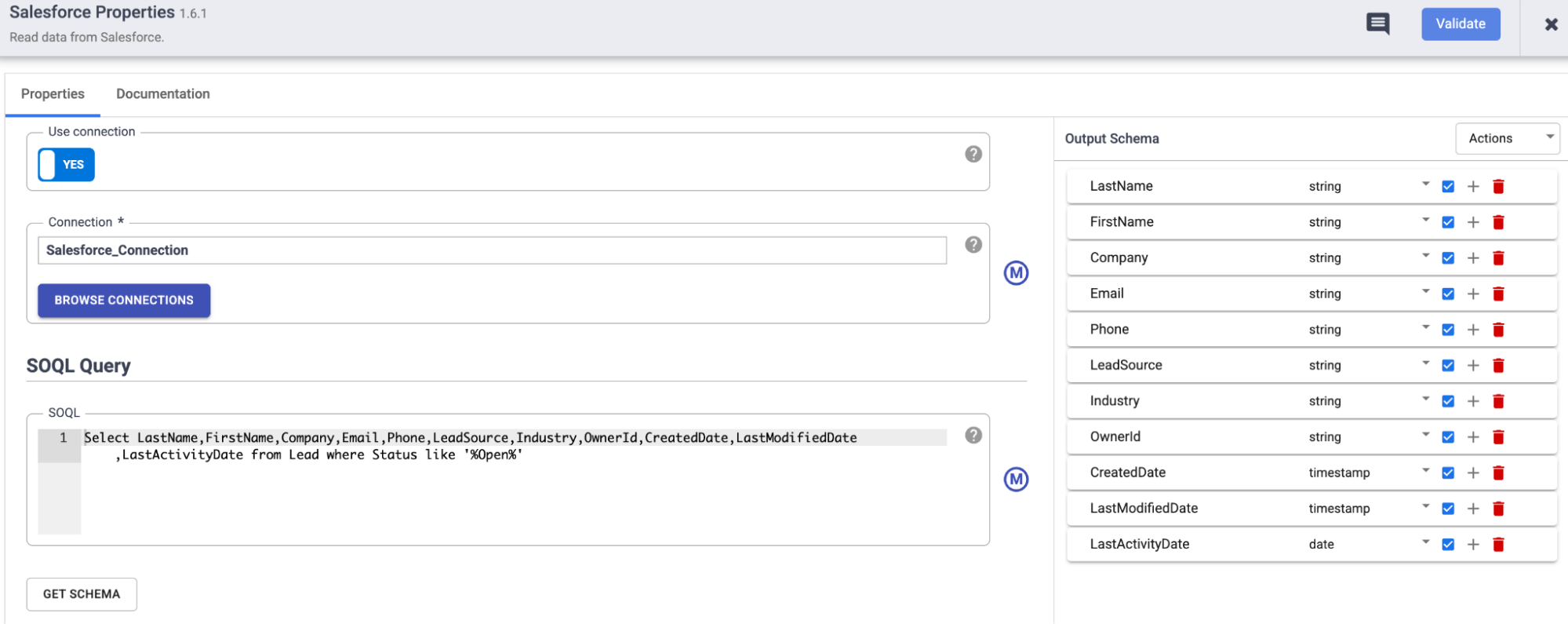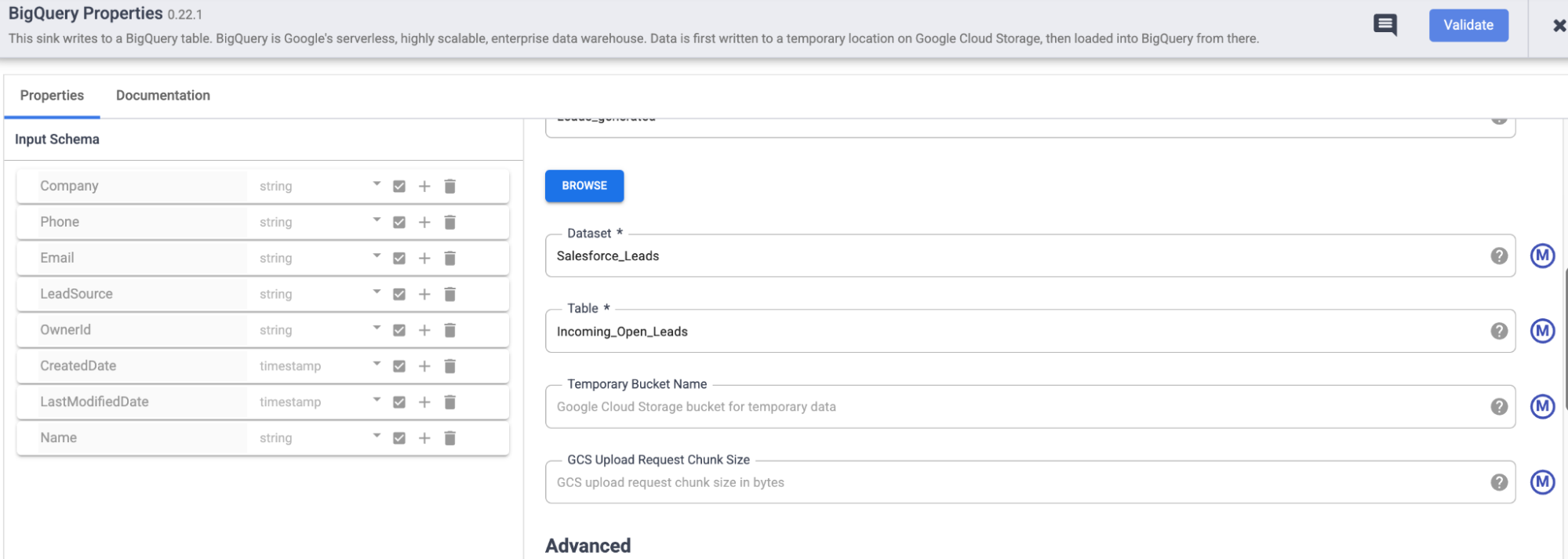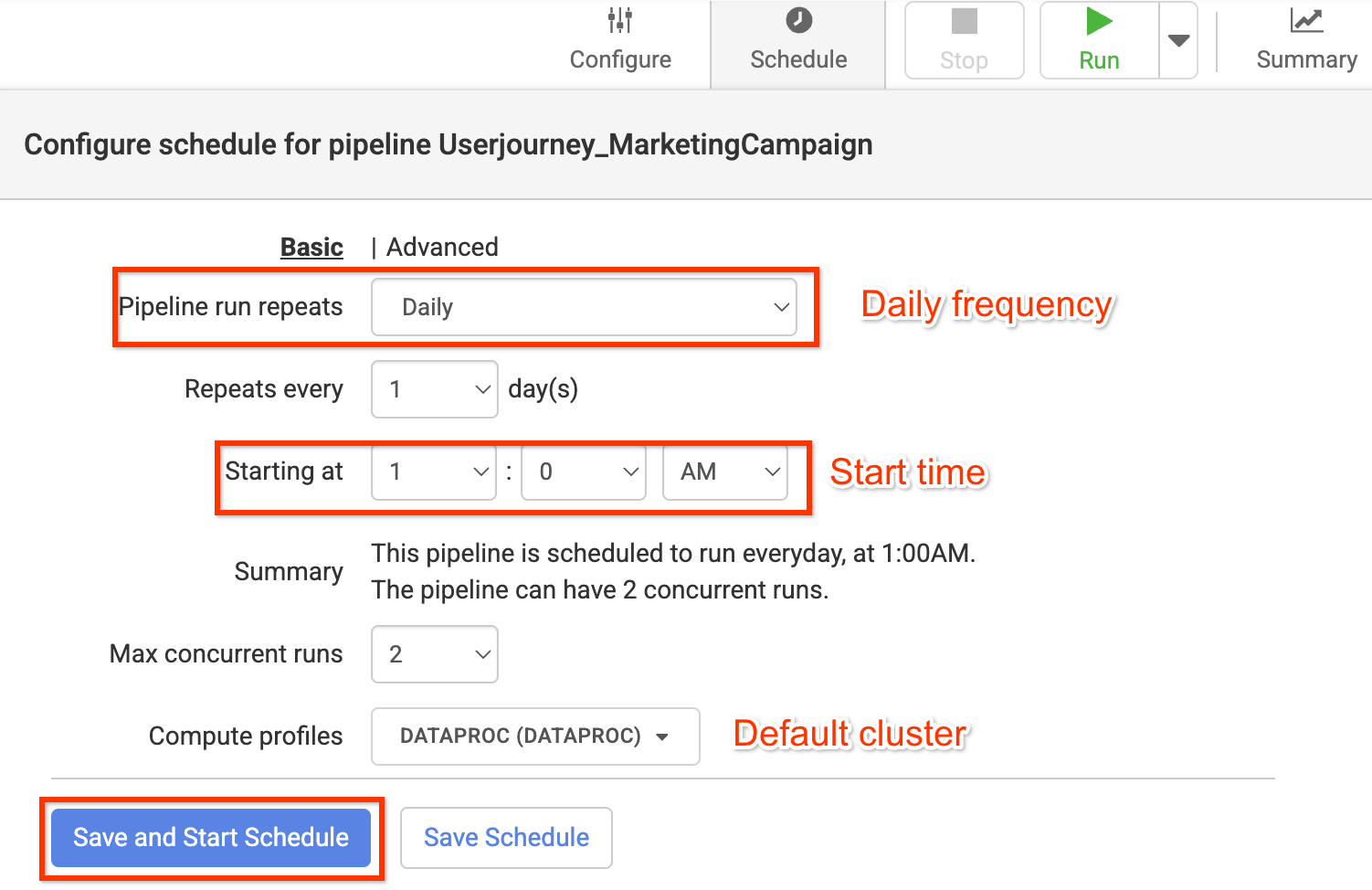使用 Salesforce Batch Source 插件来分析 BigQuery 中的潜在客户数据
了解如何在 Cloud Data Fusion 中使用 Salesforce Batch Source 插件来分析 BigQuery 中的潜在客户数据。
如需在 Google Cloud 控制台中直接遵循有关此任务的分步指导,请点击操作演示:
场景
假设一位营销经理正在策划一项高度精细的电子邮件营销活动,以宣传新产品。您在 Salesforce Sales Cloud 中有一个潜在客户名单。在制作定位广告系列之前,为了更好地了解目标受众群体,您希望使用 Cloud Data Fusion 中的 Salesforce Batch Source 插件提取特定的潜在客户数据。
准备工作
- Sign in to your Google Cloud account. If you're new to Google Cloud, create an account to evaluate how our products perform in real-world scenarios. New customers also get $300 in free credits to run, test, and deploy workloads.
-
In the Google Cloud console, on the project selector page, select or create a Google Cloud project.
Roles required to select or create a project
- Select a project: Selecting a project doesn't require a specific IAM role—you can select any project that you've been granted a role on.
-
Create a project: To create a project, you need the Project Creator
(
roles/resourcemanager.projectCreator), which contains theresourcemanager.projects.createpermission. Learn how to grant roles.
-
Verify that billing is enabled for your Google Cloud project.
-
In the Google Cloud console, on the project selector page, select or create a Google Cloud project.
Roles required to select or create a project
- Select a project: Selecting a project doesn't require a specific IAM role—you can select any project that you've been granted a role on.
-
Create a project: To create a project, you need the Project Creator
(
roles/resourcemanager.projectCreator), which contains theresourcemanager.projects.createpermission. Learn how to grant roles.
-
Verify that billing is enabled for your Google Cloud project.
-
Enable the Cloud Data Fusion, BigQuery, Cloud Storage, and Dataproc APIs.
Roles required to enable APIs
To enable APIs, you need the Service Usage Admin IAM role (
roles/serviceusage.serviceUsageAdmin), which contains theserviceusage.services.enablepermission. Learn how to grant roles. - 创建 Cloud Data Fusion 实例。
- 通过为 Cloud Data Fusion 创建 Salesforce 关联的应用,配置与 Salesforce API 的连接。
在 Google Cloud 控制台中,前往角色页面:
点击 创建角色。
在书名字段中,输入
Custom Role-Tutorial。点击 添加权限。
在添加权限窗口中,选择以下权限,然后点击添加:
bigquery.datasets.createbigquery.jobs.createstorage.buckets.create
点击创建。
前往 Cloud Data Fusion 实例页面:
点击您实例的名称。
记下默认的 Compute Engine 服务账号。实例详情页面包含此信息。
Cloud Data Fusion 默认 Compute Engine 服务账号名称的格式为
CUSTOMER_PROJECT_NUMBER-compute@developer.gserviceaccount.com。转到 IAM 页面:
在 Filer 栏中,输入您的默认 Compute Engine 服务账号的名称。
对于默认的 Compute Engine 服务账号,请点击 修改。
点击 添加其他角色。
在请选择一个角色字段中,选择 Custom Role-Tutorial(自定义角色 - 教程)。
点击保存。
管理权限
创建并分配所需的自定义角色和权限。
创建自定义角色并添加权限
为默认的 Compute Engine 服务账号分配自定义角色
配置 Cloud Data Fusion Salesforce Batch Source 插件
前往 Cloud Data Fusion 实例页面:
对于您的实例,请点击查看实例。系统随即会打开 Cloud Data Fusion 网页界面。
前往 Studio 页面。
点击 Hub。
在搜索栏中,输入
Salesforce。点击 Salesforce plugins(Salesforce 插件),然后点击部署。
在 Salesforce 插件部署窗口中,点击完成。
部署完成后,系统会显示一个对话框,其中包含成功消息。
在该对话框中,点击创建流水线。
此时会显示 Cloud Data Fusion Studio 页面。
选择 Data pipeline - batch(数据流水线 - 批量)作为数据流水线的类型。
在来源菜单中,点击 Salesforce。
转到 Salesforce 节点,然后点击属性。这会打开 Salesforce 插件属性页面。
在 Reference name(参考名称)字段中,输入来源的名称。例如
Leads_generated。在连接部分,点击使用连接切换开关。
点击浏览连接。系统随即会打开 Browse connections(浏览连接)窗口。
点击添加连接,然后选择 Salesforce。
在 Create a Salesforce connection(创建 Salesforce 连接)窗口中,点击配置标签页,然后执行以下操作:
在名称字段中,输入用于标识连接的名称,例如
Salesforce_connection。在凭据部分中,输入 Salesforce 账号的以下详细信息:
- 用户名
- 密码
- 使用方密钥
- 使用方密钥
- 安全令牌
点击测试连接。 如果输入的详细信息正确无误,测试会成功,并显示“已成功连接”的消息。
点击创建。
选择 Salesforce_connection 并返回 Salesforce 插件属性页面。
从 Salesforce Batch Source 插件提取数据
在 Salesforce 插件属性页面的 SOQL query(SOQL 查询)部分,输入以下查询:
Select LastName,FirstName,Company,Email,Phone,LeadSource,Industry,OwnerId,CreatedDate,LastModifiedDate,LastActivityDate from Lead where Status like '%Open%'此查询从 sObject
Lead中提取投放广告系列所需的潜在客户的详细信息。如需确定对象架构的有效性,请点击获取架构。
如需针对广告系列投放,按特定日期或时间过滤记录,请使用以下字段:
- 上次修改日期晚于
- 上次修改时间早于
- 时长
- 偏移值

使用 Wrangler 插件转换数据
使用 Cloud Data Fusion 中的 Wrangler 插件可清理并丰富您的数据:
返回 Studio 页面。
在转换菜单中,点击 Wrangler。
将 Wrangler 连接到 Salesforce Batch Source 插件。
前往 Wrangler 插件,然后点击属性。这会打开 Wrangler 插件属性页面。
确保已填充 Input schema(输入架构)。
点击 Wrangler。
在连接窗格中,选择一个有效的连接。
选择要转换的 sObject,例如
Lead。使用所需的指令转换数据:
keep :LastName,:FirstName,:Company,:Phone,:Email,:LeadSource,:OwnerId, :CreatedDate,:LastModifiedDate,:LastActivityDatemerge :FirstName :LastName :Name ' ' fill-null-or-empty :Email 'no email found' mask-number :Phone ########xxxxxxxx format-date :LastActivityDate yyyy-MM-dd HH:mm:ss drop :LastName,:FirstName
将数据加载到 BigQuery 中
返回 Studio 页面。
在水槽菜单中,点击 BigQuery。
转到 BigQuery 节点,然后点击属性。这会打开 BigQuery 插件属性页面。
在基本部分的 Reference name(参考名称)字段中,输入用于标识此接收器的名称。例如
Leads_generated。在数据集字段中,输入表所属的数据集。例如
Salesforce_Leads。在表字段中,输入需要用于存储所提取记录的表。例如
Incoming_Open_Leads。如需验证插件,请点击验证。

部署、安排和运行流水线
如需部署流水线,请点击部署。
如需使用调度器设置适当的刷新时间表,请按以下步骤操作:
- 点击时间表。
输入以下详细信息:
- 流水线运行重复
- 重复频率
- 起价
- 最大并发运行数量
- 计算配置文件
点击 Save and start schedule(保存并启动时间表)。

如需运行流水线,请点击运行。
验证数据提取和注入
在 Google Cloud 控制台中,前往 BigQuery 页面:
搜索数据集
Salesforce_Leads和表名称Incoming_Open_Leads以查看提取的记录。如需运行查询,请点击查询。
分析潜在客户数据,更好地了解您的受众群体并大规模投放量身定制的广告系列。
清理
为避免因本页中使用的资源导致您的 Google Cloud 账号产生费用,请按照以下步骤操作。
删除 Cloud Data Fusion 实例
请按照以下说明删除 Cloud Data Fusion 实例。
删除项目
为了避免产生费用,最简单的方法是删除您为本教程创建的项目。
要删除项目,请执行以下操作:
- In the Google Cloud console, go to the Manage resources page.
- In the project list, select the project that you want to delete, and then click Delete.
- In the dialog, type the project ID, and then click Shut down to delete the project.

